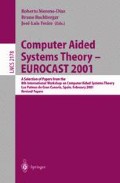Abstract
The different aspects of classical neural nets are treated here at the light of Systems Theory. First, we consider McCulloch-Pitts-Blum formalisms, which are regarded as biological counterparts of logical machines (automata). Systems Theory inspired the introduction of state transition and functional matrices, to treat problems of analysis, synthesis, stability and oscillations. The so called McCulloch Program I is completed by the development of systems technics to allow the neural synthesis of arbitrary probabilistic automata. Next, nets to integrate sensorial functions, as well as intermodal integration and effector action are considered, which corresponds to a level higher than the “molecular” neuron-like computing element. Finally, at the highest level, modules for the so called generalized robotic-like behavioral systems are presented, in line with the known McCulloch-Problem II. This includes a diagram for a behavioral system under a command and control subsystem of the type of the reticular formation of vertebrates.
Access this chapter
Tax calculation will be finalised at checkout
Purchases are for personal use only
Preview
Unable to display preview. Download preview PDF.
References
McCulloch, W.S., Pitts, W.H.: A Logical Calculus of the Ideas Immanent in Nervous Activity. Bull. Math. Byophys.9(1943) 127–247
Moreno-Díaz, R.: Natural and Artificial Neural Nets. In: Genetic Algorithms in Engineering and Computer Science. Winter, Periaux, GalÁn, Cuesta (eds.). Wiley (1995) 83–109
Blum, M.: Properties of a Neuron with Many Inputs. In: Principles of Self organitation. Von Foerster, Zopf, R. (eds.). Pergamon Press, New York (1961) 95–119
McCulloch, W.S., Papert, S.A., Blum, M., da Fonseca, J.S., Moreno-Díaz, R.: The Fun of Failures. New York Academy of Sciences, 156, 2
Austrich, J., Moreno-Díaz, R.: Incidencia de la Teoría de Neuronas Formales en la Formulación de Procesos Retinales. In: Biocibernética: Implicaciones en Bilogía, Medicina y Tecnología. Moreno-Díaz, R., Mira, J. (eds.). Siglo XXI, Madrid (1984) 231–244
Schnabel, K.: Number of Modes of Oscillation of a Net of N Neurons. In: Q.P.R. 80, Research Laboratory of Electronics, MIT., Cambridge, MA. (1966), 253
da Fonseca, J.S.: Synthesis and Linearization of Feedback Shift Registers: Basis for a Model of Memory. In: Q.P.R. 86 Research Laboratory of Electronics, MIT., Cambridge, MA. (1967) 355–366
Moreno-Díaz, R., McCulloch, W.S.: Circularities in Nets and the Concept of Functional Matrices. In: Biocybernetics of the Central Nervous System. Proctor, L. (ed.). Little and Brown, MA. (1969) 145–150
Moreno-Díaz, R., HernÁndez-Guarch, F.: On the Biological Formal Counterparts of Logical Machines. Kybernetics 12 (1983) 183–185
McCulloch, W.S.: Embodiments of Mind. The MIT Press, Cambridge, MA (1965)
Mira, J., Moreno-Díaz, R., Delgado, A., SuÁrez, C.P.: Intersensory Communication in Machines as Paradigms of Cortical Reliability. In: Cybernetics and Systems, Vol. I. Rose (ed.) Thales Pub., England (1987) 432–437
Sutro, L.: Sensory Decision and Control System, R-548, Charles Stark Draper Laboratory, MIT (1966)
Kilmer, W.: A Global Inhibitory Model for Deciding Modes of Attention: Functions of the Nucleus Reticulari Thalami. In: Brain Processes, Theories and Models. Moreno-Díaz, R., Mira, J. (eds.), The MIT Press, Cambridge, MA (1996) 125–133
Moreno-Díaz, R., Mira, J., SuÁrez, C.P., Delgado, A.: Neural Net to Compute Auditive Invariances. Proc. V Med. Conf. on Med. and Biolog. Engineering, Patras, Greece (1989) 302–303
Moreno-Díaz, R.: CAST Methods in Biocybernetics. In: Computer Aided System Theory. Lecture Notes in Computer Science, 1798. Pichler, F., Moreno-Díaz, R., Kopacek (eds.) (2000) 8–13
Editor information
Editors and Affiliations
Rights and permissions
Copyright information
© 2001 Springer-Verlag Berlin Heidelberg
About this paper
Cite this paper
Moreno-Díaz, R., de Blasio, G. (2001). Systems Methodology for Classical Neural Nets at Various Levels. In: Moreno-Díaz, R., Buchberger, B., Luis Freire, J. (eds) Computer Aided Systems Theory — EUROCAST 2001. EUROCAST 2001. Lecture Notes in Computer Science, vol 2178. Springer, Berlin, Heidelberg. https://doi.org/10.1007/3-540-45654-6_24
Download citation
DOI: https://doi.org/10.1007/3-540-45654-6_24
Published:
Publisher Name: Springer, Berlin, Heidelberg
Print ISBN: 978-3-540-42959-3
Online ISBN: 978-3-540-45654-4
eBook Packages: Springer Book Archive

